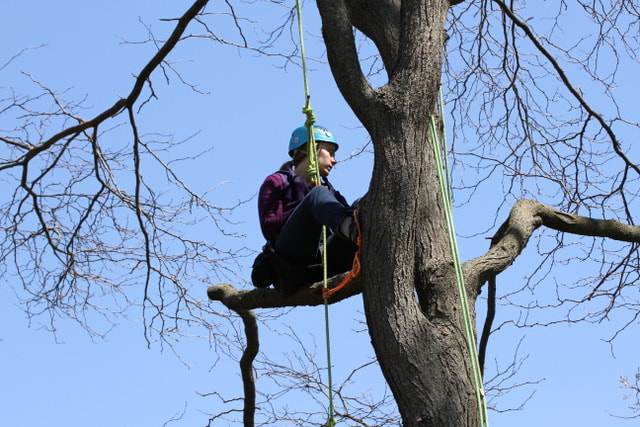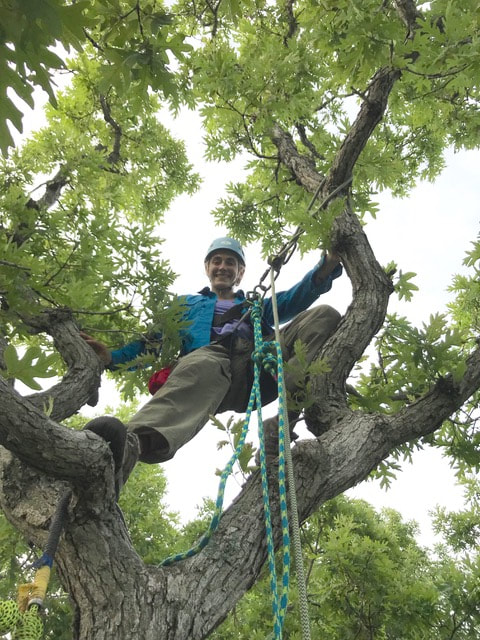|
By Emma Koeppel Baltimore Orioles are a brilliant orange and black bird. They migrate from Central America to the northernmost parts of the United States every year and herald the beginning of spring in Wisconsin. The Cornell Lab of Ornithology describes their song as “pure, liquid, whistling tones.” They can often be found singing their liquid gold song from the uppermost treetops, pausing between melodies to search for a tasty insect snack. For years I never paid much attention to orioles. This spring that changed. I started seeing and hearing them everywhere. On my morning hikes, in my backyard tree, flittering ahead of me as I walked around the neighborhood. Also around this time, I had my first experience with tree climbing. I hadn’t intended to climb that day but stumbled upon the opportunity. Within minutes of lifting my feet off the ground, I knew I was never looking back to a tree-climbing-less life. On my most recent climb, I was perched on a branch high in the tree a couple of hours before sunset. I had been climbing all day so I was sweaty and tired. Gnats were swarming around my face and I had a good-sized blister that was letting me know it was there. As I sat, I let the quiet sink in. I let my breathing slow and let my body feel supported by the tree branch underneath me. And there it was. A female oriole dancing through the treetops. In some ancient cultures, orioles symbolize a positive change or a ray of sunshine entering your life. Regardless of whether or not animals hold any symbolic power over our stories as humans, tree climbing has certainly been a welcome ray of sunshine in my life. When I climb trees, I feel invigorated and full of energy. At the same time, it’s like traveling back in time to childhood when I spent hours perched in my favorite tree. Climbing into a tree as an adult re-awakened feelings of wonder and awe that I didn’t know had been missing. It allowed me to literally perceive the world from a new angle. This awakened a desire to perceive more of my life from new angles. While the feelings that tree-climbing will evoke are different for everyone, I do think tree-climbing has some inherent benefits that can be powerful to anyone who climbs! Tree climbing provides challenges.
The nature of tree-climbing is such that you can choose any challenge that suits you. Maybe you are scared of heights and your goal is to get 5 feet off the ground. That is a great goal! Maybe you hope to climb high enough to sit on the lowest branch. Maybe you want to scurry as high into the tree as possible and look out over the city below. Tree climbing can meet you where you are comfortable, while at the same time inspiring you to push beyond your comfort zone. And trust me, when you do push beyond it, you’ll feel great! A chance to slow down and notice.
To notice the moss growing on the limb next to you. To notice how your body feels as it pushes you higher and higher into the tree. To notice the texture of the bark. To notice your thoughts slowing down. As our days speed up, slowing down and noticing are two things that often get thrown to the wayside. We rush from one place to the next, checking tasks off of our to-do lists. Kids may find themselves in this busy pattern, too. Many of the kids I know will gladly fill their after-school time with soccer, dance, theater, basketball, baseball, piano lessons, violin lessons, and the list goes on. Of course, all of these activities are enriching in their own right, but it’s easy to become unbalanced. A balance of the fast rushing with slow noticing creates important space. Tree climbing may be a place where you can devote all of your attention to a single goal for an hour, thus treating yourself to a much-needed break from the rushing that we all experience sometimes. Tree climbing provides connection. On my first climb I felt connected to the tree, to the other climbers, and to the facilitators. In order to participate in the process of climbing the tree, I had to have a baseline level of respect and trust in the people and environment surrounding me. Connection breeds trust, respect, and shared values and experiences. If we don’t feel a connection to something or someone, we are much less likely to show them care and respect. We all know the benefits of feeling connected to other people; that connection makes us feel understood, supported, and valued. But what about the benefits of feeling connected to a tree? Those are a bit harder to grasp or put into words. On a fundamental level, trees keep us alive. They provide oxygen for us to breath. Along with oxygen, trees give us shelter, material, food, relaxation, water, and beauty. If we don’t interact with trees in our daily routines, it can be hard to develop a connection to them. Subsequently, trees and the environment we call home may not always receive the respect and care that they deserve from us. Spend an hour in the canopy of a tree and maybe you’ll walk away with a new sense of connection!
1 Comment
Thanks to Hartford Recreation Department and TNF Videos for creating a fantastic video about the experience of tree climbing! See it from beginning to end and hear what it’s like straight from the kids and their parents.
“It’s a really good experience; something they’ve never been able to do before.” - Jennifer Schroeder “It’s scary, it’s fun, it’s a blast, it’s a workout.” - Aldon Kaye Tree Climbing from TnF Videos / Rachel Womack on Vimeo. |
AuthorAs a G.O.T.C. Recognized Master Instructor & Facilitator, I.S.A. Board Certified Master Arborist, and T.C.I.A. Certified Treecare Safety Professional, Curt has spent over 30 years dedicated to the study and care of trees. Categories
All
Archives
May 2024
|
|



 RSS Feed
RSS Feed
